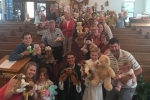March 2022
Caretakers of God's Creation
Creation Care and Community Engagement
Coming in as the new vicar to Church of the Holy Spirit four years ago, I met a faithful, core group of Jesus followers whose passion for God and ministry in the world included a deep care for God’s creation. Though many of this core group are aging and less spry than before (aren’t we all, though?) they continued to wonder with me what our call looks like in the particular place where we’re planted as Christ’s Body.
Thinking about caring for God’s creation as a ministry and not a program or activity, we found ourselves first contemplating our relationships. We began with the land around our church building. It includes a community garden space that hadn’t been maintained in some seasons and ten acres of woods with a disused nature trail, also from years back. It’s not that we didn’t have a relationship to the land where we also worshiped, but some connections were broken, and others needed nurture.
When we looked around further, we realized that we could say the same thing about our relationships with our neighbors and wider community. While our church believes in connecting and collaborating with others outside our membership for the sake of seeking peace and restoring what’s been damaged in our social life, over the years our connections to neighbors, like our land, needed tending.
A ministry built on relationships
We wanted to imagine a ministry involving care for creation that could restore our caring relationships with the land and its creatures and with our human neighbors.
Our approach was to nurture existing relationships and form new ones. We talked with church members, neighbors, parents, students, teachers and city employees, asking about what caring for creation meant to them.
What we quickly learned is that we are already connected to communities that can offer vibrant collaborations.
In our conversations, we learned that elementary and high schools, as well as technical schools and universities, are full of educators looking for community partners to develop applied service-learning opportunities for their students. Churches can become wonderful sites for learning, growth, experimentation and connection!
We served as an internship site for some environmental studies students from a local university. They helped lead a trail clearing day, and throughout the spring they documented native flowers and herbs in the woods. They attended Sunday worship to share what they were discovering.
Involving the neighboring community
Ministry like this means going out to spaces like university environmental studies classrooms that aren’t necessarily about “church” or even spirituality, at least not on the surface. It’s meant being open to people outside our church membership, being curious about their needs and interests and passions, and saying “yes!” as often as possible to their ideas.
In our experience, those outside our church bring perspectives and knowledges to creation care that we need, while our “churchy” commitment to the divinity inherent in every part of creation is interesting and appealing to young people hungry for soul connection to the careers they’re in educational training for.
We’ve also connected to a fifth grade class in a multi-year partnership for community-based service learning, inviting them to spend the first year building a relationship with the land (the woods, trail and garden) and experiment with building places along the trail for spiritual contemplation and eco-spiritual refreshment.
As we invite others to co-steward this part of creation, we don’t rush into projects, but instead make time to linger, walk, stop and listen and learn to perceive the life around us that is a reflection of our Creator, to whom we are all bound in cycles of life and death and rebirth.
These young people are already developing skills for “reading” the environment and sharing what they’re experiencing. Members of our church with Native American ancestry are working with them to envision planting native herbs along the path to design educational and spiritual healing grounds. Neighbors who hadn’t engaged the church before are noticing the activity, the laughter and trail clearing taking place in the woods, and stopping by to ask how they might be involved.
Forming community relationships takes extra time and energy, to be sure. But it’s worth it, to see relationships unfolding among people who formerly were only loosely connected to each other and to creation. We’re wondering together about how to create an organic garden, new brush piles for woodland creature habitats and a nature trail that invites people closer to God and non-human kindred.
How to begin
Ask questions.
Start by asking members of your congregation who are teachers, school staff, parents and students about the community-oriented projects and assignments in which they’re involved. At most educational levels and institutions, community-engaged service learning is more of a priority, and climate change and environmental stewardship are concerns for many young people.
Ask this.
How could our church’s landscape (no matter how small or large) become a place for equipping people, particularly young people in our wider community, to learn, grow and try out ideas for care of creation?
Show up in new spaces.
One of our community collaborations was made possible when, as the vicar, I went to a public screening of a documentary about the environmental impacts of Hurricane Maria (having seen the flier on a university list serve a church member got me onto). During the Q & A, I asked a question and let drop my church wanted to be more engaged in creation care. Afterward, multiple professors approached me asking how our church might be a place where their students could fulfill requirements for community-engaged projects.
Not every church may have the kind of acreage we do, but the approach to creation care that we’re finding most rewarding can work whether you have 10 acres, 1 acre, or less.
Care for creation as a ministry involves a deep commitment to becoming grounded in your particular place, and growing with your neighbors and wider community in the capacity to know, love and care for the plants, rocks, animals, air, water and soils in the name of love and in the name of Christ.
The Rev. Audra Abt serves in Greensboro, North Carolina, as the Vicar at Church of the Holy Spirit and Mission Developer for Abundant Life Health & Healing, a new Episcopal community and collaborative ministry of the Episcopal Diocese of North Carolina. Both of these communities are multi-lingual and intercultural expressions of their neighborhoods, with members from Latin America, West Africa, the Caribbean and from around the U.S. She became an ECF Fellow in 2015 while developing a bilingual base community in Greensboro among Central American and U.S.-born neighbors. These leaders are helping Holy Spirit and Abundant Life envision a model of basic Christian community that can thrive and bear witness to God’s powerful presence in the world, even during this pandemic.
Resources:
- Formation Moves into the Neighborhood by Greg Syler, an ECF Vital Practices blog, April 4, 2019
- Sustainability in the Scrappy Church by Nancy Frausto, Vestry Papers, July 2017
- Sharing the Bounty of God’s Garden by Bill Eakins, Vestry Papers, November 2018
- Greening Our Faith – Putting Belief into Action by Fletcher Harper, Vestry Papers, March 2011






